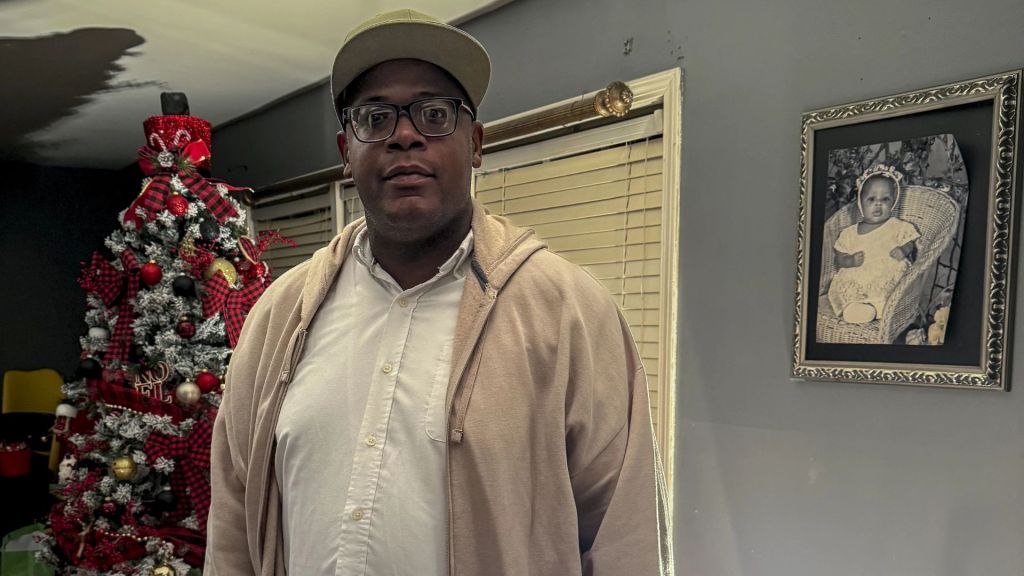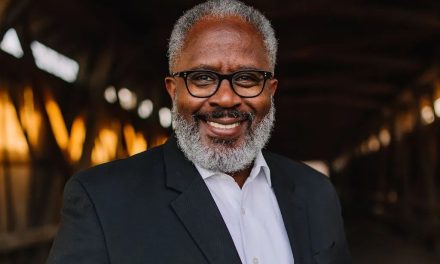By Robin Mcdowell and Margie Mason
The Associated Press
A storm was looming when the inmate serving 20 years for armed robbery was assigned to transport fellow prisoners to their jobs at private manufacturers supplying goods to companies like Home Depot and Wayfair. It didn’t matter that Jake Jones once had escaped or that he had failed two drug and alcohol tests while in lockup — he was unsupervised and technically in charge.

Credit: AP Photo
By the time Jones was driving back to the work release center with six other incarcerated workers, it was pelting rain. Jones had a reputation for driving fast and some of his passengers said he was racing along the country road, jamming to music in his earbuds. Suddenly, the transport van hit a dip and swerved on the wet pavement, slamming into a tree.
Two men died after being thrown out of the van. And Jones, who was critically hurt and slumped over the blaring horn, had to be cut out of the vehicle. As the other men staggered into the storm to flag down help, they wondered: Why would the Alabama Department of Corrections place their lives in Jones’ hands?
“They knew he had a propensity to drink,” said Shawn Wasden, who survived the crash. “And they put him behind the wheel of a van anyway.”
No state has a longer, more profit-driven history of contracting prisoners out to private companies than Alabama. With a sprawling labor system that dates back more than 150 years — including the brutal convict leasing era that replaced slavery — it has constructed a template for the commercialization of mass incarceration.
Best Western, Bama Budweiser and Burger King are among the more than 500 businesses to lease incarcerated workers from one of the most violent, overcrowded and unruly prison systems in the U.S. in the past five years alone, The Associated Press found as part of a two-year investigation into prison labor. The cheap, reliable labor force has generated more than $250 million for the state since 2000 through money garnished from prisoners’ paychecks.
Most jobs are inside facilities, where the state’s inmates — who are disproportionately Black — can be sentenced to hard labor and forced to work for free doing everything from mopping floors to laundry. But more than 10,000 inmates have logged a combined 17 million work hours outside Alabama’s prison walls since 2018, for entities like city and county governments and businesses that range from major car-part manufacturers and meat-processing plants to distribution centers for major retailers like Walmart, the AP determined.
While those working at private companies can at least earn a little money, they face possible punishment if they refuse, from being denied family visits to being sent to higher-security prisons, which are so dangerous that the federal government filed a lawsuit four years ago that remains pending, calling the treatment of prisoners unconstitutional.
Though they make at least $7.25 an hour, the state siphons 40 percent off the top of all wages and also levies fees, including $5 a day for rides to their jobs and $15 a month for laundry.
Turning down work can jeopardize chances of early release in a state that last year granted parole to only 8 percent of eligible prisoners — an all-time low, and among the worst rates nationwide — though that number more than doubled this year after public outcry.
“It is a symptom of a completely, utterly broken system,” said Chris England, an Alabama lawmaker pushing for criminal justice reform.
Many prisoners work 40 hours a week outside their facilities and then get weekend passes, allowing them to go home without any supervision or electronic monitoring. So when prisoners are then told they’re too dangerous to be permanently released, England said, it looks like “another way to create a cheap labor force that is easily exploited and abused.”
Arthur Ptomey, who has worked at various private companies over the past six years, said he was denied parole in 2022 after losing his job at KFC, where he had complained about his low wages. A full-time cook, he was upset that even teenagers working the register were outearning him despite the fact that he had worked there for over a year.
Ptomey is one of 10 current and former prisoners who filed a class-action federal lawsuit last year against state officials, local governments and businesses like McDonald’s and Wendy’s franchises, contending they perpetuate a system of forced labor akin to a “modern-day form of slavery” that keeps the best workers from being released.
He currently works at Progressive Finishes, one of the state’s biggest contractors of prison labor, which says on its website that it has served as a third-party supplier to automotive companies including Honda, General Motors, Ford, Toyota, Nissan, Kia, Volvo, Chrysler and Hyundai.
“For a lot of these jobs, the attitude is the same … if you don’t meet our expectations, we’ll just call for somebody else,” Ptomey said while on a 48-hour home pass at his mother’s house. “I’m grateful to come out and work, but I ain’t come in here to be a slave.”
Kelly Betts of the corrections department defended the work programs, calling them crucial to the success of inmates preparing to leave prison. But she acknowledged that even those sentenced to life without the possibility of parole are eligible for so-called work release jobs.
That’s because in Alabama the department determines which prisoners are employed off site largely based on how well they’ve behaved behind bars, instead of what put them there. Those working among the civilian population include men and women with records for violent crimes like murder and assault. Many are serving 15 years or longer.
“Many choose work to being confined to a facility all day,” Betts said. “In many cases, it is a matter of quality of life. But ultimately, the inmate chooses and is not penalized for non-participation.”
Alabama’s lockups are chronically understaffed, and it’s not unusual for prisoners to work outside their facilities without any correctional oversight. And in some cases, there is no supervision of any kind, which has led to escapes, often referred to as “walkaways.”
Asked how prisoners are chosen to work without monitoring, Betts said, “Each inmate’s situation is unique, and each inmate is evaluated on his or her own record.”
Most companies did not respond to requests for comment, but the handful that did said they had no direct involvement with work release programs.
Home Depot said it would investigate its connection to outdoor furniture maker Wadley Holdings, where some men in the van crash were working. It said it prohibits suppliers from using prison labor and would take action if policy violations are found.
McDonald’s said in a statement it does not permit the use of prison labor within its supply chain or at its corporate-owned restaurants and is “committed to promoting ethical employment practices.” The fast food giant added that while franchisees operate independently, they are expected to respect human rights and are encouraged to develop similar policies.
Best Western also said it does not participate in personnel matters at its independently owned and operated hotels. Hyundai said it knew some of its suppliers hired inmates for jobs but was not involved in the decision to do so. Honda said it was not aware of any business relationship with Progressive Finishes, which is common with companies and third-party suppliers.
As part of its investigation, the AP analyzed 24 years of Alabama corrections department monthly statistical reports to calculate the amount of money generated via contracts with private companies and deductions taken out of prisoners’ paychecks.
Reporters also parsed information from more than 83,000 pages of data obtained through a public records request, including the names of inmates involved in Alabama’s work programs. In addition to working for public entities — everywhere from landfills to the governor’s mansion — they were leased out to at least 500 private businesses between 2018 and mid-March 2024. That information was cross-referenced with an online state database, detailing the crimes that landed people in prison, their sentences, time served, race and good-time credits earned and revoked. The AP analysis faced limitations because some workplace entries were insufficiently defined.
Few prisoner advocates believe outside jobs should be abolished. In Alabama, for instance, those shifts can offer a reprieve from the excessive violence inside the state’s institutions. Last year, and in the first six months of 2024, an Alabama inmate died behind bars nearly every day, a rate five times the national average.
But advocates say incarcerated workers should be paid fair wages, given the choice to work without threat of punishment, and granted the same workplace rights and protections guaranteed to other Americans.
Prisoners nationwide cannot organize, protest or strike for better conditions. They also aren’t typically classified as employees, whether they’re working inside correctional facilities or for outside businesses through prison contracts or work release programs. And unless they are able to prove “willful negligence,” it is almost impossible to successfully sue when incarcerated workers are hurt or killed.
Though the Alabama corrections department said it could not provide information about the number of prisoners who died while on outside jobs, the AP tracked down family members of prisoners who lost their lives. One man was killed after being sucked into a machine at a plant operated by massive poultry processor Koch Foods and others died after being struck by vehicles while picking up trash or doing road maintenance on the side of busy highways.
The day of the van accident, Jake Jones had finished his shift at a nearby Quality Inn, where his boss and co-workers told the AP that nothing seemed amiss. He headed to the Alexander City work center, where he was a go-to driver, and grabbed the keys to the white Ford Econoline so he could shuttle his fellow prisoners to their jobs. He had about four hours of driving ahead of him, zipping between a string of companies up to 40 minutes apart.
Tyrone Heard, one of the passengers dropped off before the crash, said Jones had been drinking and that he believed staff knew it. Before heading out, he said he overheard two officers discussing whether they should find another driver.
An hour into the trip, Heard said, Jones “told us he was drunk.” At one point, he added, Jones smashed his foot on the gas until the speedometer topped 90 mph.
About two hours later, the van was wrapped around the tree. Heard’s uncle, Willie Crayton, was killed instantly. Bruce Clements struggled to breathe and died on the way to the hospital.
The accident report estimated the van’s speed was 67 mph upon impact — more than 20 mph over the speed limit. Blood tests were conducted to determine if drugs or alcohol were in the driver’s system, but those results have never been released. Police, volunteer firefighters and emergency medical responders would not comment, saying the case remained under investigation.
Betts, the corrections department spokeswoman, said Jones met all the criteria to be an inmate driver: Though he failed drug and alcohol tests in 2018 and 2022 — and another about a month after the accident — he passed his screening test two days before the deadly crash.
And prison guidelines only bar participation of prisoners who escaped or were recaptured within a 10-year period. His escape was in 2010.
Jones, who since has been moved to a higher-security facility, did not respond to questions from the AP.
Some of the men involved in the crash have been released from prison after serving their sentences, but others continue to report to outside jobs.
They still ride past the crash site, marked by a simple cross — with Willie Crayton’s hat resting on top.
“One dies, get another”
Prison labor is enshrined in the 13th Amendment of the U.S. Constitution, which banned slavery and involuntary servitude – except for those convicted of a crime. That language also was added to the constitutions of many states, though eight of them have removed the so-called punishment clause in recent years after taking the issue to voters.
In 2022, Alabama became one of them, but Gov. Kay Ivey signed an executive order last year giving the corrections department the authority to revoke good-time credits — days shaved off sentences rewarding model behavior — for “refusing to work,” making it harder for even the best prisoners to accelerate their release.
“The people just say that they thought it was unconstitutional, inhumane … and you come back and say, ‘I don’t care,’” said Robert Earl Council, who is part of the federal lawsuit filed last year against forced labor in prison. “It verifies clearly to me the point that we’ve been trying to drive home … this is strictly, explicitly about the money.”
Council, also known as Kinetic Justice, spent five years in solitary confinement for helping lead prison work stoppages — including one that spread to facilities in several other states. At one point, he and other inmates also began hunger strikes, demanding an end to free labor.
Throughout the state’s history of prison labor, money has been a key driver.
Soon after the Civil War, when the South’s once-booming economy was in tatters, Alabama turned to convict leasing. Young, mostly Black men were arrested for petty crimes like gambling or vagrancy and hired out to private companies. They were forced to build railroads, work in sawmills and toil under deplorable conditions in coal mines, including those owned by U.S. Steel — the biggest company in the world at the time.
No state in America earned more from convict leasing than Alabama — at one point, it accounted for more than 70 percent of all annual revenue. It was also where companies made the most money. By the time Alabama became the last state to officially ban the practice in 1928, thousands of prisoners had died from rampant disease, dangerous working conditions and poor treatment. Incarcerated workers were treated as disposable, reflected in a quote at the time: “One dies, get another.”
Alabama shifted its strategy when industries began to modernize and mechanize, said Douglas Blackmon, whose book “Slavery by Another Name” chronicles the state’s dark past of convict leasing.
“Up until that moment, the practices were so profitable for both government officials and industry … that they would always find a way to continue the system,” he said. “It’s something that people have figured out how to make a lot of money on again. And so the practice reemerges.”
Fast forward to the 1970s, when conditions were so bad — from abysmal treatment of inmates with mental illnesses to extreme violence — that a U.S. federal judge took control of Alabama’s entire prison system.
That’s when the Department of Corrections decided to classify inmates largely by their behavior behind bars rather than their criminal histories, ostensibly to help alleviate overcrowding. Under the new standards, eligible participants would not only get paid for their outside jobs, but also have their sentences reduced for every day worked.
The system was adopted over the objections of Oscar Adams, the state’s first Black Supreme Court justice, who noted that the vast majority of those accepted would not get “good time” because prisoners sentenced to more than 10 years — later pushed to 15 — were ineligible. At the time, they represented the bulk of the prison population.
That population continued to grow, mostly due to historically harsh sentencing laws that put people away for life, even if they were convicted of nonviolent crimes. And so did its workforce.
Today, the state has a patchwork of programs that includes not just work centers — including jobs for the city and state paying $2 a day — but also work release programs operated at the county level, sometimes by nonprofit organizations. They receive about $10 a day for every person they house, plus hefty fees paid by prisoners for things like mandatory drug testing.
Some see the largely autonomous county programs as exploitative, but others call them a lifeline.
“It taught me how to be a man,” said Matthew Smith, who has a history of drug addiction and worked at a poultry plant through a community corrections work release program. “It taught me how to get up and go to work every day.”
Even prisoners who are happy working often complain about the steep pre-tax deductions taken by the state. After a 40-hour week, many say they end up pocketing only about $100 to $200.
But for the hundreds of private companies that hire them, the benefits are robust. Businesses pay at least minimum wage, but can earn up to $2,400 in tax credits for some inmates hired. Amid crushing staff shortages, they can rely on a steady, pliable workforce available to take extra shifts, fill in at the last minute when civilian workers call in sick and also work holidays. And if an incarcerated worker is injured or even killed on the job, the company may not be liable.
The same is true for businesses across the country. As part of its larger investigation, the AP spoke to more than 120 current and former prisoners and relatives of those who died on the job. Reporters found that the use of incarcerated workers is so pervasive nationwide that prison labor has seeped into the supply chains of some of the country’s largest companies and retailers — and also goods being exported.
Trader Joe’s, Cargill, McDonald’s and other companies responded to that reporting earlier this year by either cutting ties with correctional departments or third-party suppliers or indicating they were in the process of doing so.
In Alabama, the roster of companies hiring inmates is vast.
In the past five years, over 500 prisoners have worked at local Wendy’s, McDonald’s, Burger King and Applebee’s restaurants alone. They also have cleaned hotels, manufactured kitchen cabinets, made yarn used in carpets, constructed doors for houses sold at national home stores like Lowe’s, and built trailers pulled behind semi trucks. They’ve helped keep cities running across the state, and worked at public country clubs and even the Supreme Court.
Alabama collected more than $13 million in work release fees in fiscal year 2024. But the prisoner lawsuit filed in federal court late last year with backing from the powerful AFL-CIO federation of unions, estimates the corrections department actually rakes in about $450 million in benefits from prison labor annually. That takes into consideration money saved by not having to hire civilians to maintain the sprawling prison system or work for government agencies.
The suit also alleges that prisoners participating in work programs with good disciplinary records have been hardest hit by plummeting parole rates, with Black workers disproportionately affected.
A decade ago, nearly half the prisoners coming up for parole were released, with no clear racial disparity, it noted. But that changed several years ago when the board began disregarding its own guidelines and denying early releases to those who scored high enough to qualify, based on criteria like their crimes, perceived risk to society and behavior behind bars. In fiscal year 2023, there were 3,583 parole hearings that resulted in 3,286 denials — including one involving a man who had been dead for 10 days.
Alabama’s attorney general’s office did not respond to a request for comment. But in successfully moving for dismissal of a similar state lawsuit filed by inmates last year, it said “slavery and involuntary servitude do not exist in the state’s prison system.”
Those who take part in work release programs do so voluntarily, the motion noted.
For members of the public buying a Blizzard at Dairy Queen or having their cars worked on in a local garage, it can be hard to distinguish incarcerated employees from their civilian counterparts. In most cases, they dress in the same clothes or uniforms. And even those clearly identified as prisoners doing more traditional jobs like road work go unnoticed by most busy motorists speeding down the state’s roads.
That was true of Braxton Moon, his mother said. He told her how terrified he was by how dangerously close cars whizzed past him, even as he held a sign warning drivers to slow down.
Angela Lindsey pleaded with her son to quit — he was making only $2 a day. But he told her that working beats being locked up around the clock.
Two weeks later, in August 2015, Lindsey received a phone call from her cousin asking: “‘Is it true?’” An officer at the work center had posted a picture of her son on Facebook with the words “Rest in peace.”
She frantically called the center over and over, only to be hung up on each time. “All of this was before I even got anything — anything — from the state,” she said. “It was on social media. It was on the news.”
And then it was confirmed: Her son had been struck by a tractor-trailer in a hit and run along the side of Interstate 65.
He had died instantly. He was just 21.
Associated Press data journalists Arushi Gupta and Larry Fenn contributed to this report.
The Associated Press receives support from the Public Welfare Foundation for reporting focused on criminal justice. This story also was supported by Columbia University’s Ira A. Lipman Center for Journalism and Civil and Human Rights in conjunction with Arnold Ventures. The AP is solely responsible for all content.
The post Alabama profits off prisoners who work at McDonald’s but deems them too dangerous for parole appeared first on AFRO American Newspapers.










